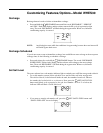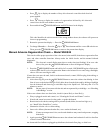
27
Routine Maintenance
Refilling With Salt
Lift the salt hole c over and che ck the salt storage level f requently. If the conditioner uses all the salt
before you refill it, you will get hard water. Until you have established a refilling routine, check the
salt e v ery two or three weeks. Always add if less than 1/4 full. Be sure the brine well cover is on.
NOTE:
In humid a reas, it is b est to keep the salt storage level lower, and to refill mo re often to
avoid sa lt bridging.
Recommended Salt: Nugget, pellet or coarse s olar salts with less than 1% impurities.
Salt Not Recommended: Rock salt, high in impurities, block, granulated, table, ice melting, ice cream
making salts, etc., are not recommended.
Breaking A Salt Bridge
NOTE:
If you see more than a few inches of water in the bottom of the tank, see “Cleaning the
Nozzle and Venturi” section.
Sometimes, a hard crust or salt bridge forms in the brine tank. It is usually caused by high humidity
or the wrong kind of salt. When the salt bridges, an empty space forms between the water and the salt.
Then, salt will not dissolve in the water to make brine. Without brine, the resin bed does not regenerate
and you will have hard water.
If the storage tank is full of salt, it is hard to tell if you have a salt bridge. Salt is loose on top, but the
bridge is under it. Take a broom handle, or like tool, hold it next to the water softener, measure the
distance from the floor to the rim of the water softener. Then push the broom handle straight down into
the salt. If a hard o bject is felt, it’s most likely a salt bridge. Carefully push into the bridge in several
places to break it. Do not use any sharp or pointed objects as you may puncture the brine tank.
Broom
Handle
Push Tool into Salt
Bridge to Break
Salt
Salt Bridge
W ater Level
Pencil
Mark
1” --- 2”
Figure 12


















